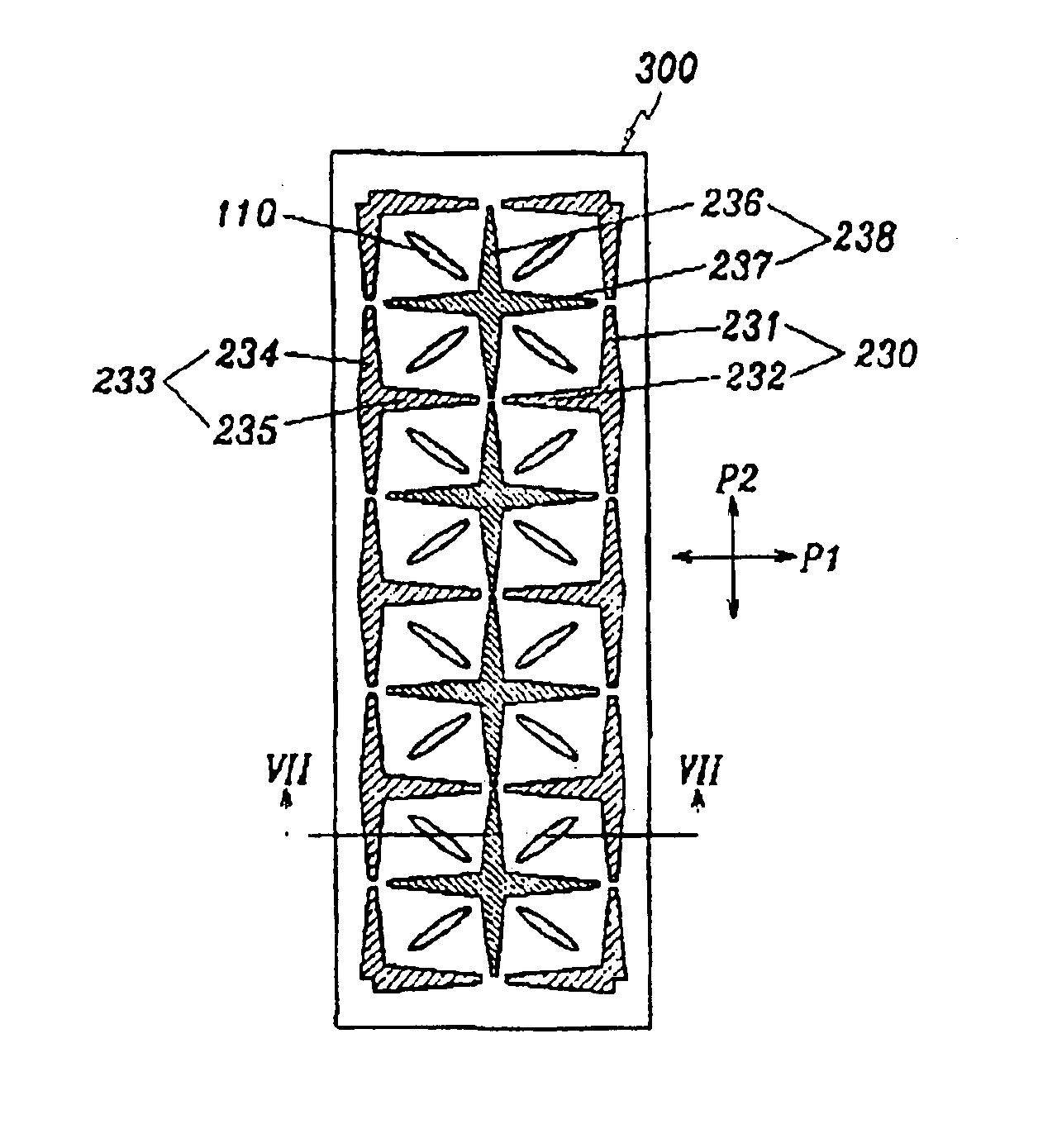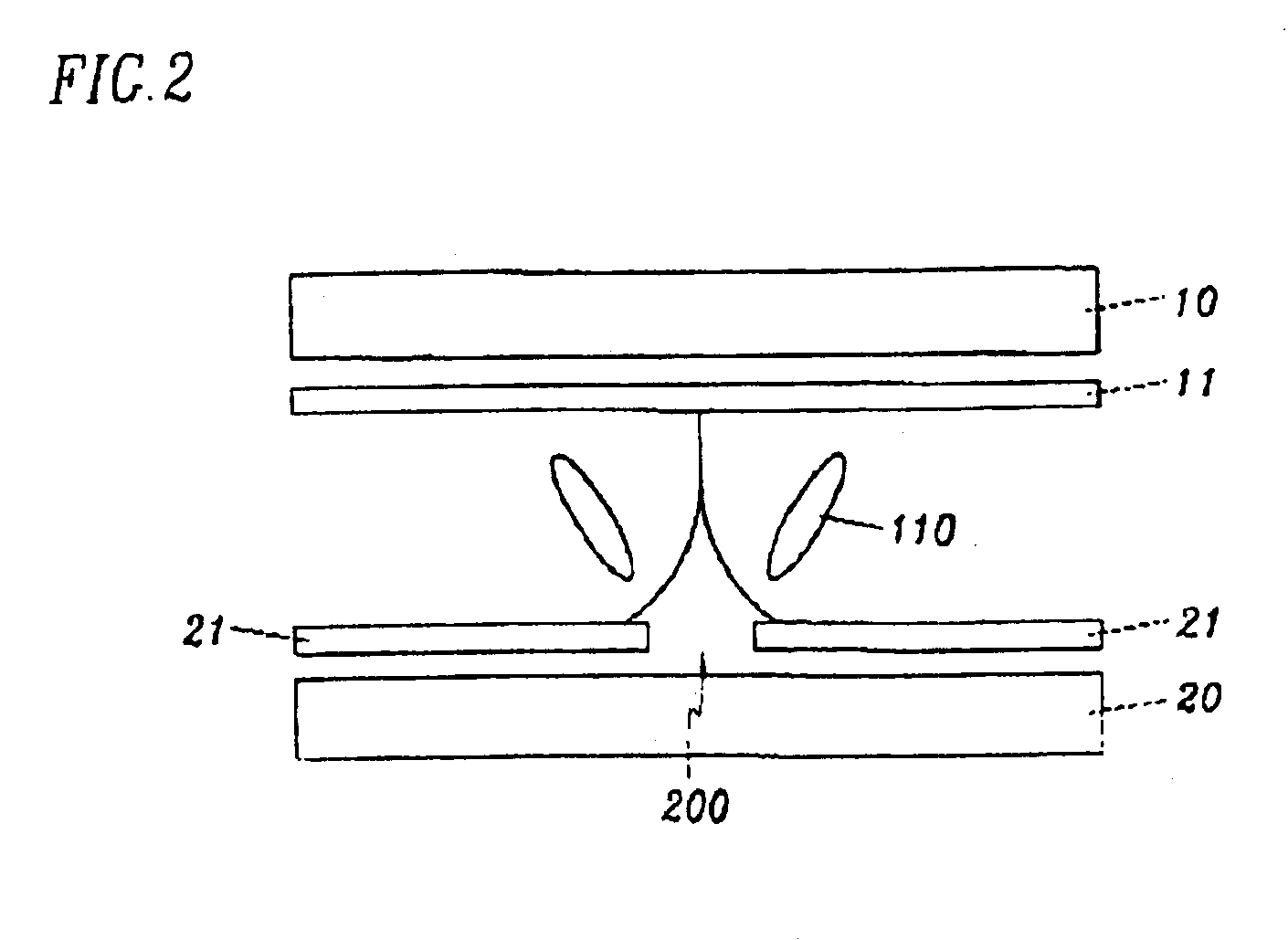Liquid crystal display having domain dividers
a liquid crystal display and domain divider technology, applied in the field of liquid crystal display, can solve the problems of not having a wide viewing angle of proposed structures and the viewing angle of vatn lcd may not be so wide, and achieve the effect of reducing disclination due to the disorder of liquid crystal molecules and wide viewing angl
- Summary
- Abstract
- Description
- Claims
- Application Information
AI Technical Summary
Benefits of technology
Problems solved by technology
Method used
Image
Examples
first embodiment
[0052]Now, considering these conditions, the present invention will be described with reference to FIGS. 3 and 4. Although an LCD has a plurality of pixels, FIGS. 3 and 4 show a single pixel region 300. In addition, only aperture patterns are illustrated in FIGS. 3 and 4, and other elements such as TFTs, wires, etc., are not illustrated.
[0053]As shown in FIGS. 3 and 4, a plurality of linear apertures 211, 212, 216 and 217 are formed in a rectangular pixel region 300. A plurality of first and second apertures 211 and 212 extending in transverse and longitudinal directions respectively are formed in an electrode 11 on an upper substrate 10, and a cross-shaped aperture 216 and 217 including first and second portions 216 and 217 extending in the transverse and longitudinal directions respectively are formed in an electrode 21 on a lower substrate 20.
[0054]The first and the second apertures 211 and 212 are separated from each other, arranged in the longitudinal direction, and form four l...
second embodiment
[0062]An aperture pattern according to the present invention shown in FIG. 5 is similar to the aperture pattern shown in FIG. 3 except for rectangular shape of the domains instead of square shape. That is, longitudinal apertures 221 and 226 are longer than transverse apertures 222 and 227. Accordingly, when viewed from the top, an angle made by the average axial directions in the adjacent domains is not exactly 90°, and an angle between the polarizing directions and the average axial directions is not exactly 45°. However, in this case, one of the transverse or longitudinal directions is preferred by the liquid crystal molecules because the long axes of the liquid crystal molecules makes a less angle with one of the two directions than with the other. Since the rearrangement of the liquid crystal molecules quickly occurred and becomes stable, the response time is relatively short than the LCD shown in FIG. 3.
[0063]A liquid crystal display exhibiting less response time is now describ...
third embodiment
[0064]FIG. 6 is a layout view of an aperture pattern of an LCD according to the present invention, and FIG. 5 is a sectional view of the LCD shown in FIG. 6 taken along the line VII-VII′.
[0065]As shown in FIGS. 6 and 7, an LCD according to the third embodiment of the present invention includes a lower TFT (thin film transistor) panel 20 and an upper color filter panel 10. Though it is not shown in the figures, a plurality of gate lines and data lines are formed on the inner surface of the TFT panel 20, and a pixel electrode 20 and a TFT (now shown) as a switching element are formed in a lower pixel region surrounded by the gate lines and data lines. On the inner surface of the color filter panel 10 opposite to the TFT panel 20, a black matrix pattern 14 which defines an upper pixel region corresponding to the lower pixel region in the TFT panel is formed, and a color filter 15 is formed therebetween. A passivation layer 16 covers the black matrix 14 and the color filter 15, and a co...
PUM
 Login to View More
Login to View More Abstract
Description
Claims
Application Information
 Login to View More
Login to View More - R&D
- Intellectual Property
- Life Sciences
- Materials
- Tech Scout
- Unparalleled Data Quality
- Higher Quality Content
- 60% Fewer Hallucinations
Browse by: Latest US Patents, China's latest patents, Technical Efficacy Thesaurus, Application Domain, Technology Topic, Popular Technical Reports.
© 2025 PatSnap. All rights reserved.Legal|Privacy policy|Modern Slavery Act Transparency Statement|Sitemap|About US| Contact US: help@patsnap.com



